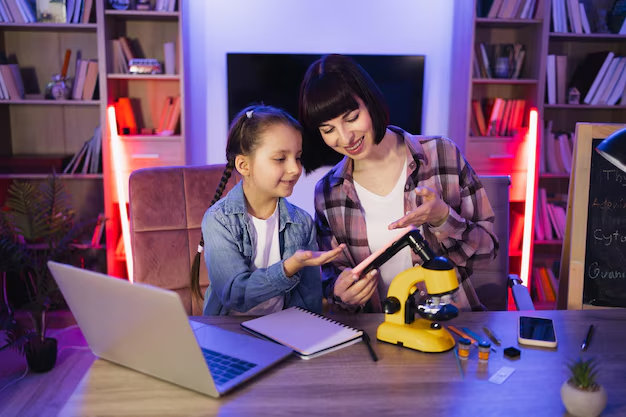La tecnología educativa (EdTech) está cambiando cómo se enseña y se aprende en universidades. Usa herramientas digitales nuevas para mejorar la educación. Esto hace que la experiencia de aprender sea mejor para los estudiantes.
El EdTech ofrece soluciones tecnológicas que mejoran la educación superior. Permite a los estudiantes aprender a su propio ritmo. Así, pueden acceder a contenidos interactivos desde cualquier lugar.
La inteligencia artificial y el análisis de datos están cambiando cómo se adapta el contenido. Esto mejora el rendimiento y la experiencia de aprendizaje de cada estudiante.
Aspectos Clave
- La tecnología educativa (EdTech) está integrando herramientas digitales innovadoras en la educación superior.
- Las soluciones EdTech permiten a los estudiantes aprender a su propio ritmo y acceder a contenidos interactivos desde cualquier lugar.
- La incorporación de inteligencia artificial y análisis de datos está transformando la forma en que se adapta el contenido a las necesidades individuales de cada estudiante.
- La tecnología educativa está democratizando el acceso a la educación al eliminar barreras físicas y socioeconómicas.
- Las plataformas de gestión del aprendizaje (LMS) han revolucionado la forma en que se distribuye y administra el contenido educativo.
Understanding EdTech’s Impact on Higher Education
The digital transformation in universities has changed how we teach and learn. Now, learning environments are more interactive and open. Educational technology (EdTech) has made it easier for everyone to get quality education, no matter their background.
Students all over the world can now learn from home with just an internet connection. This has been especially helpful in areas with limited resources. Teachers can now make their lessons more engaging and tailored to each student’s needs.
Digital Transformation in Universities
A study looked at 46 research studies on using technology in education. It found that the main problems were lack of training and resources. Also, not everyone had access to the internet or digital tools.
Evolution of Learning Environments
The study focused on nine countries in Latin America. It found that there was a lack of local capacity to create educational technology. There were also financial and policy issues that made it hard to adapt to new learning environments.
The OECD noted a digital gap in the region. This gap could leave some people without access to the benefits of technology-enhanced learning.
Accessibility and Global Reach
To meet sustainable development goals, universities in LATAM need to embrace digital transformation. They must create modern learning environments. This will help make education more accessible and global.
However, there are challenges. Limited digital literacy and technology could make universities unprepared for the job market. This could worsen social and demographic issues in the region.
| Key Findings | Statistic |
|---|---|
| Number of empirical research studies analyzed | 46 |
| Initial number of articles identified | 234 |
| Number of articles removed due to duplication, unavailability, or language | 81 |
| Number of articles included in the final analysis | 46 |
The Rise of Learning Management Systems (LMS)
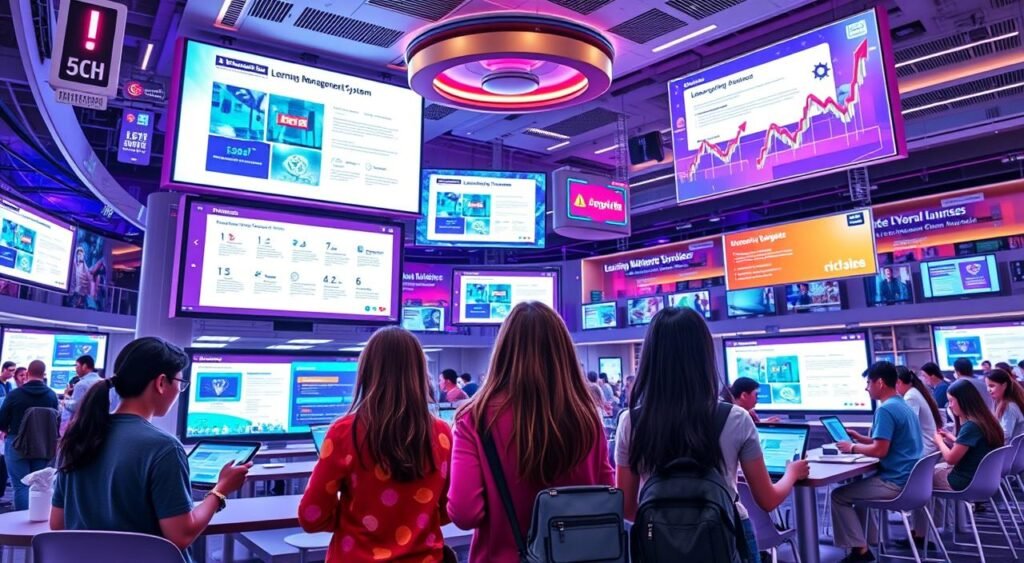
Learning Management Systems (LMS) have changed how universities share and manage educational content. Tools like Moodle, Blackboard, and Canvas are key for schools wanting to boost plataformas LMS, gestión del aprendizaje, and teaching efficiency.
Popular LMS Platforms and Their Features
Moodle is open-source and highly customizable, fitting schools’ unique needs. Blackboard has strong features, including análisis de datos educativos and teamwork tools. Meanwhile, Canvas is known for its easy-to-use design and better student-teacher interaction.
Benefits of LMS Integration
LMS platforms help organize and share course materials better. They also make it easier to track and evaluate student progress. This leads to a more dynamic and accessible learning space, boosting rendimiento estudiantil.
Data Analytics and Student Performance Tracking
With LMS, análisis de datos educativos has become more detailed. Teachers can use this data to understand student performance better. They can then adjust their teaching methods to help students improve.
«The shift towards innovative teaching methods, collaborative teaching, and technology-enhanced learning has been accelerated by EdTech adoption.»
Tecnología Educativa: Tools and Platforms Revolutionizing Education
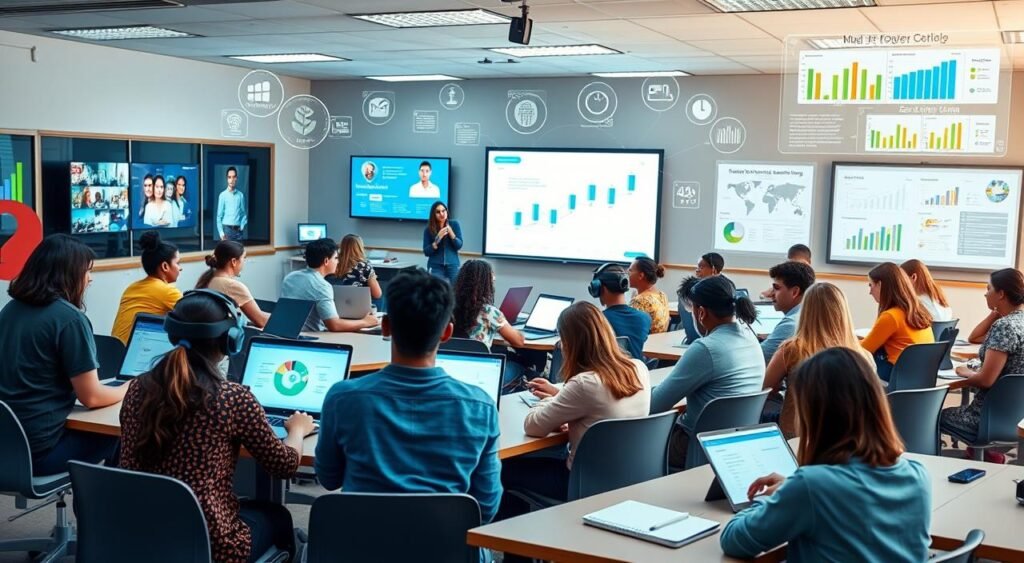
In today’s digital world, many herramientas educativas (educational tools) and plataformas digitales (digital platforms) are key in teaching and learning. They help manage educational content well and improve colaboración en línea (online collaboration) between students and teachers.
Tools like Slack, Zoom, and Trello are important for teamwork and real-time talks. Google Classroom and Microsoft Teams make learning and teaching easier. They offer better ways to work together and make education more accessible and efficient.
The growth of recursos educativos abiertos (Open Educational Resources or OER) and online courses has changed education. Sites like Khan Academy and Coursera offer quality learning to anyone with internet. This has made education available worldwide.
| Digital Tool or Platform | Key Features |
|---|---|
| Slack | Real-time messaging, file sharing, and team collaboration |
| Zoom | Video conferencing, virtual classrooms, and webinar hosting |
| Trello | Project management, task organization, and team coordination |
| Google Classroom | Streamlined communication, assignment distribution, and feedback |
| Microsoft Teams | Integrated collaboration, virtual meetings, and content sharing |
| Khan Academy | Free, high-quality online educational content and courses |
| Coursera | Online courses and certifications from leading universities and institutions |
These herramientas educativas and plataformas digitales have changed education. They make learning more efficient, collaborative, and accessible for everyone.
Artificial Intelligence and Personalized Learning Experiences
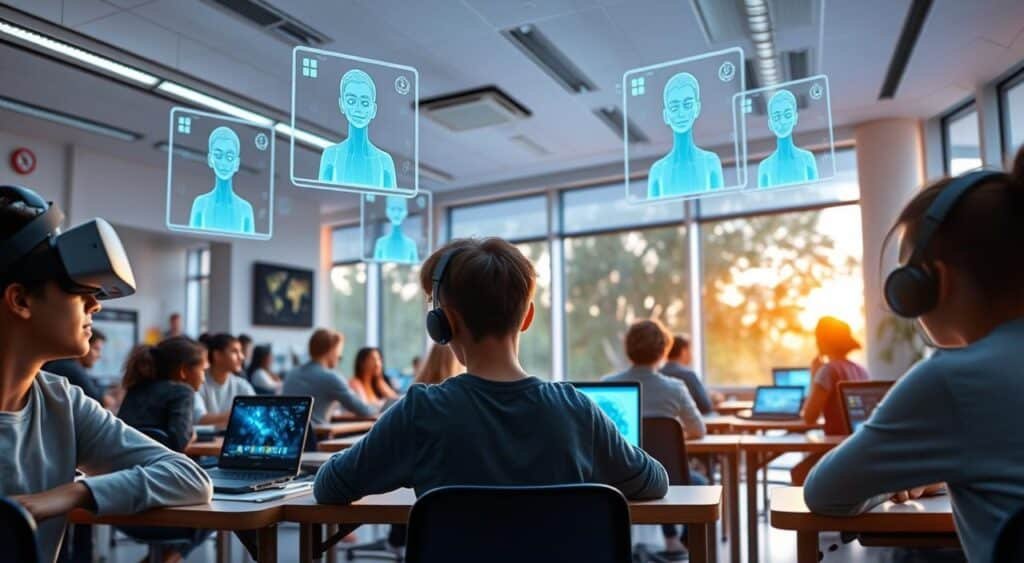
Artificial intelligence (AI) is changing education, making learning personal for each student. It helps schools deliver content, assess students, and analyze their performance in new ways. This change is exciting and promising for the future of learning.
AI-Driven Content Adaptation
AI lets learning platforms adjust content for each student’s needs and learning style. It uses algorithms to understand a student’s progress and preferences. Then, it changes the content, pace, and difficulty to fit their learning best.
This approach makes sure every student gets the help they need to succeed. It’s a big step towards making education more effective and supportive.
Smart Assessment Systems
AI-powered assessment systems give more accurate and timely feedback on student performance. They analyze answers in real-time, find knowledge gaps, and offer feedback and help right away. This lets teachers focus on helping students more, making learning better for everyone.
Predictive Analytics in Education
AI predictive analytics use data to forecast student success, find students at risk, and suggest learning paths. It looks at lots of data, like grades, engagement, and behavior. This helps teachers make better decisions and tailor lessons for each student.
AI is making education more efficient, engaging, and personal. As it keeps improving, we’ll see even more ways it can change learning. It’s a powerful tool for helping students reach their highest potential.
Digital Collaboration and Virtual Learning Environments
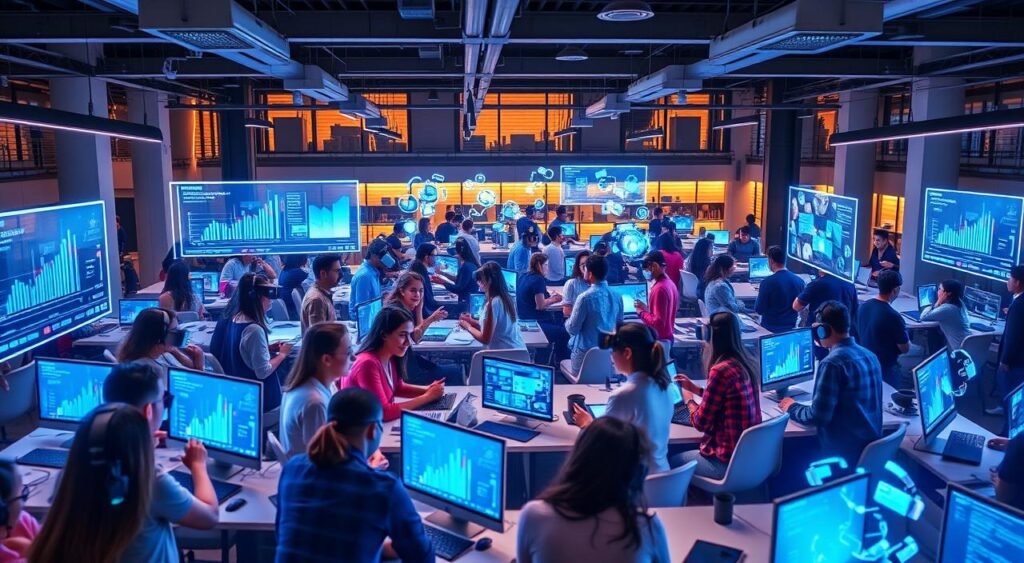
In today’s education world, digital tools for teamwork and online learning spaces are key. Tools like Slack, Zoom, and Microsoft Teams help students and teachers work together, no matter where they are. They make it easy to chat and share ideas in real time, creating a sense of community online.
Online learning spaces offer a place where students can dive into their studies, join discussions, and work on projects together. These digital areas are especially helpful for schools that teach online or mix online and in-person classes. They make sure learning keeps going and is open to everyone.
Using these digital tools helps students learn how to work together online, a skill needed in today’s job market. By mastering digital teamwork, students get ahead in their careers, ready to succeed in the digital world.
| Popular Digital Collaboration Platforms | Key Features |
|---|---|
| Slack | Seamless communication, file sharing, and team collaboration |
| Zoom | Versatile video conferencing, virtual meetings, and webinars |
| Microsoft Teams | Integrated collaboration tools, real-time chat, and file sharing |
As schools grow, using digital tools and online learning spaces will be crucial. They help create flexible, open, and connected learning experiences for everyone.
Emerging Technologies Shaping University Education
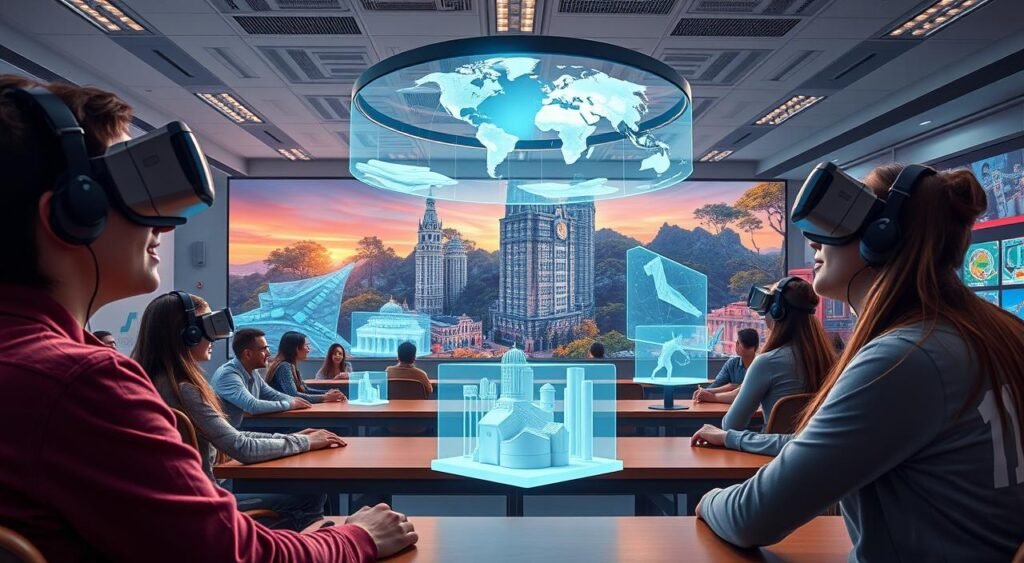
The world of education is changing fast, thanks to new technologies. Virtual and augmented reality, mobile learning, and cloud-based resources are changing how we learn. These tools are making studying more fun and interactive.
Virtual and Augmented Reality in Education
Realidad virtual en educación and realidad aumentada are opening new doors for students. Medical students can practice surgeries in virtual labs. History students can explore ancient places without leaving their classrooms.
Mobile Learning Solutions
Aprendizaje móvil is making learning easy on the go. With smartphones and tablets, students can learn anywhere. They can check their homework, join discussions, and submit work from anywhere.
Cloud-Based Educational Resources
Recursos educativos en la nube are changing how we share and use educational materials. Cloud platforms make it easy to work together and share files. Students can access lots of digital resources from anywhere.
| Technology | Impact on University Education | Benefits |
|---|---|---|
| Virtual and Augmented Reality | Immersive learning experiences, enhanced visualization of complex concepts | Improved engagement, better understanding of subject matter |
| Mobile Learning Solutions | Increased accessibility and flexibility, personalized learning experiences | Improved student engagement, better learning outcomes |
| Cloud-Based Educational Resources | Collaborative learning, seamless access to educational content | Reduced reliance on physical materials, enhanced resource sharing |
These new technologies are making learning better and preparing students for the future. By using these tools, universities can help students succeed in a digital world.
Also Read: Becas Universitarias: Guía Paso a Paso para Aplicar
Conclusion
The use of educational technology in universities is changing how we learn. It includes AI for personalized learning and VR experiences. These tools make learning more engaging, accessible, and effective.
Universities are now better at getting students ready for the digital age. They are using new tech to improve how we learn.
The future of education combines old teaching methods with new tech. This creates a learning space that is more open, flexible, and effective. We will focus on building digital skills, encouraging innovation, and supporting lifelong learning.
This shift will help students succeed in the digital world. It will give them the skills needed to face the 21st century’s challenges. This change will make learning better and prepare a workforce ready for the future.
FAQs
Q: ¿Cómo está revolucionando la tecnología educativa el aprendizaje en las universidades?
A: La tecnología educativa está transformando el aprendizaje en las universidades a través de la integración de herramientas digitales que facilitan la enseñanza y el acceso a recursos educativos, mejorando así la experiencia de aprendizaje para los estudiantes.
Q: ¿Cuáles son las tendencias en tecnología educativa en el contexto universitario?
A: Algunas de las tendencias incluyen el uso de plataformas de aprendizaje en línea, la gamificación, la realidad aumentada y virtual, así como la personalización del aprendizaje a través de la inteligencia artificial.
Q: ¿Qué papel juega la evaluación de la tecnología educativa en la enseñanza universitaria?
A: La evaluación de la tecnología educativa es crucial para medir la efectividad de las herramientas utilizadas, asegurando que contribuyan positivamente a los procesos de aprendizaje y a la innovación educativa.
Q: ¿Cómo se aplica la tecnología educativa en el aula universitaria?
A: La aplicación de la tecnología educativa en el aula se realiza a través de métodos como el aprendizaje colaborativo en línea, el uso de recursos multimedia y la implementación de software educativo que permite a los estudiantes interactuar de manera más efectiva con el contenido.
Q: ¿Qué beneficios ofrece la integración de la tecnología educativa en la formación de los estudiantes?
A: La integración de la tecnología educativa ofrece beneficios como el acceso a una mayor cantidad de recursos, la flexibilidad en el aprendizaje, y la capacidad de desarrollar habilidades tecnológicas que son esenciales en el mercado laboral actual.
Q: ¿Cómo afecta el uso de la tecnología educativa en el desarrollo de la evaluación de los estudiantes?
A: El uso de la tecnología educativa en la evaluación permite métodos más dinámicos y variados, como las evaluaciones en línea y el feedback instantáneo, mejorando la calidad de la retroalimentación y el aprendizaje continuo de los estudiantes.
Q: ¿Qué desafíos enfrenta la implementación de la tecnología educativa en las universidades?
A: Algunos de los desafíos incluyen la resistencia al cambio por parte de algunos educadores, la necesidad de formación continua en el uso de nuevas tecnologías, y las limitaciones de infraestructura que pueden afectar el acceso a recursos tecnológicos.
Q: ¿Cómo puede la investigación contribuir a la innovación educativa en el campo de la tecnología educativa?
A: La investigación puede contribuir a la innovación educativa al identificar mejores prácticas, evaluar el impacto de diferentes tecnologías en el aprendizaje, y desarrollar nuevas soluciones que respondan a las necesidades cambiantes de los estudiantes y profesores.
Q: ¿Cuál es la importancia de los estudios sobre el uso de la tecnología educativa en la universidad?
A: Los estudios sobre el uso de la tecnología educativa son importantes porque proporcionan evidencias sobre su efectividad, ayudan a informar políticas educativas, y guían la formación de los docentes en la aplicación de estas herramientas en el aula.
Q: ¿Qué impacto tiene la tecnología educativa en el diseño de los cursos universitarios?
A: La tecnología educativa impacta el diseño de los cursos al permitir una mayor flexibilidad en la metodología de enseñanza, la incorporación de diferentes formatos de contenido, y la posibilidad de personalizar el aprendizaje según las necesidades de los estudiantes.
Source Links
- https://www.santander.com/es/stories/tecnologia-educacion
- https://iuv.edu.mx/2024/11/12/tecnologia-educativa-como-el-edtech-revoluciona-el-aprendizaje/
- https://ekora.com.co/revolucionando-el-aprendizaje-la-era-de-la-tecnologia-en-la-educacion/
- https://link.springer.com/article/10.1007/s10639-023-11846-x
- https://pmc.ncbi.nlm.nih.gov/articles/PMC9376914/
- https://elearningindustry.com/top-educational-technology-trends-2020-2021
- https://link.springer.com/article/10.1007/s44217-024-00143-5
- https://www.eschoolnews.com/digital-learning/2024/01/03/what-is-an-educational-technology-tool/
- https://fundacionaulasmart.org/en/blogs/noticias/the-5-main-trends-in-educational-technology-by-2025?srsltid=AfmBOoox2H9rOKgtHq3BvHd_NWRfsdLtsNlTwarnnfUSgEJwIcUQZ8Ne
- https://news.stanford.edu/stories/2024/02/technology-in-education
- https://www.frontiersin.org/journals/education/articles/10.3389/feduc.2024.1424386/full
- https://files.eric.ed.gov/fulltext/EJ1135332.pdf
- https://rgsa.openaccesspublications.org/rgsa/article/view/7083
- https://aws.amazon.com/blogs/publicsector/moving-to-virtual-classrooms-heres-how-edtechs-can-help/
- https://www.worldbank.org/en/topic/edutech
- https://www.linkedin.com/advice/1/how-can-faculty-members-ensure-emerging-dcmxc
- https://www.uaeh.edu.mx/scige/boletin/prepa4/n5/e6.html
- https://es.slideshare.net/slideshow/estudiante-universitaria-132956138/132956138
